Nesting Turtles at Home in Suburbia
Air Date: Week of July 15, 2016
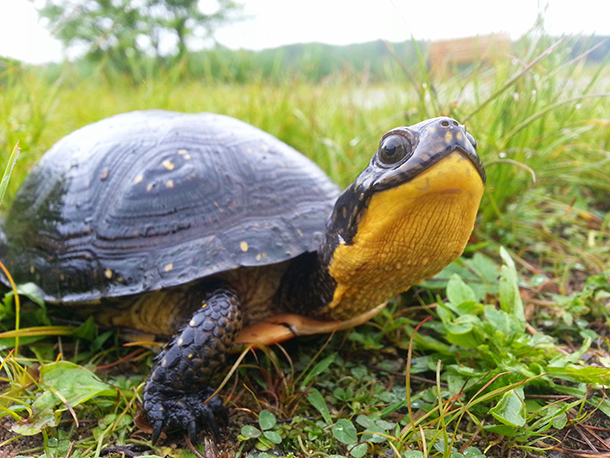
The bright yellow throat of the Blanding’s turtle can help biologists recognize one from a distance (Photo: Emilie Schuler / Grassroots Wildlife Conservation)
Habitat loss, the dangers of roadways, and other hazards have reduced the population of the locally threatened Blanding’s turtle in the Northeast. The nonprofit Grassroots Wildlife Conservation has teamed up with local residents to safeguard the nests that mother Blanding’s turtles make in their neighborhoods, often in the landscaping of homeowners. Living on Earth’s Jenni Doering tagged along with GWC Executive Director Bryan Windmiller and his team in Concord, Massachusetts to tell the story.
Transcript
CURWOOD: It’s Living on Earth, I’m Steve Curwood. Head Start is a US government program designed to give children from vulnerable, low-income families a better shot at doing well in school as well as later in life. Today, we have a story of another intervention program, based in the wetlands of Concord, Massachusetts. But this one is for turtles, and Living on Earth’s Jenni Doering went to check it out.
[SOUNDS OF A SUMMER EVENING]
DOERING: On a summer evening at Great Meadows National Wildlife Refuge, you’re surrounded by tall reeds, lily pads on shallow ponds, and turtles. And if you’re really lucky, you’ll spot the dark, high-domed shell and bright yellow throat of a Blanding’s turtle basking on a log. The turtles are right at home here, but Massachusetts lists them as a threatened species. That’s partly because young Blanding’s turtles face many dangers.
WINDMILLER: They have maybe a 1 in 80, 1 in 100 chance of living to be adults.
Chris Hickling holds up a radiotracking antenna at Great Meadows National Wildlife Refuge (Photo: Emilie Schuler / Grassroots Wildlife Conservation)
DOERING: That’s Bryan Windmiller, the Executive Director of Grassroots Wildlife Conservation. The nonprofit is working to shift those odds and give baby Blanding’s turtles a better start in life – appropriately -- by sending these youngsters to school so young humans can care for them and raise them for a year.
WINDMILLER: And we call that “head starting,” you know, from like from the human Head Start program. We give the little turtles a head start in life. We give them at least a forty-fold increase in their chances of surviving to adulthood.
DOERING: The head start cycle begins each summer during turtle nesting season, when Bryan and his team search for the mother Blanding’s nests to protect them. I tag along, and we start by getting our feet wet.
[SPLASHING SOUNDS]
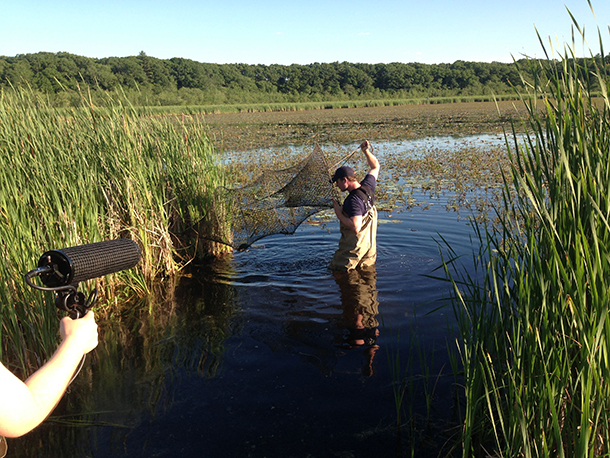
When he checks the first hoop trap, Chris finds a Blanding’s turtle inside (Photo: Don Lyman)
DOERING: One of the interns working at Grassroots this summer wades into the thigh-deep water at Great Meadows.
HICKLING: I’m Chris Hickling, I’m going to be a rising senior at the University of Richmond.
[MORE SPLASHING SOUNDS]
DOERING: Wearing rubber chest waders like Chris, I follow him into the pond and we head for a large mesh trap set up a few yards from the muddy bank.
WINDMILLER: So that we can determine how many there are, how many boys, how many girls, how many young ones, how many old ones, and so that we can get hold of some of the ladies and we can radio track them to where they nest, we start out by trapping them.
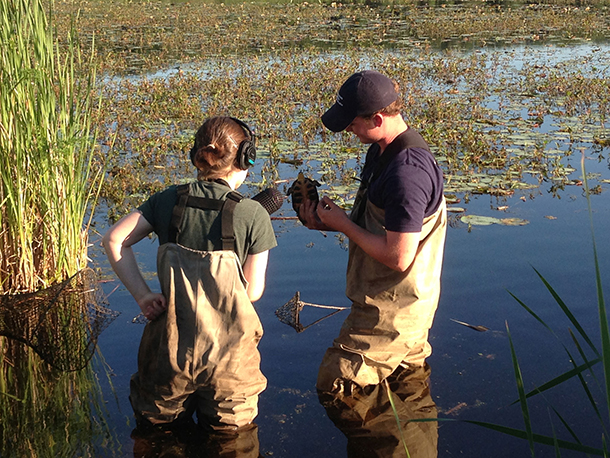
Chris tells Living on Earth’s Jenni Doering about a Blanding’s turtle uncovered from the trap. (Photo: Don Lyman)
[MORE WATER SOUNDS]
DOERING: Chris opens the trap.
DOERING: All right, what have we got?
HICKLING: We have two painted turtles, and one Blanding’s turtle; and this Blanding’s turtle does not appear to be fully grown – the shell’s pretty worn for a young turtle.
DOERING The team uses a marking system that gives each turtle a number so they can record it in a database. This turtle’s shell is about six inches long, and Chris points to marks notched around the edge.
HICKLING: So how we mark them is -- so these are the ones, the tens, the hundreds, and the thousands. And each of them has a notch number. So this’d be one, two, three, you see he’s notched here.
DOERING: So it’s like going around the face of a clock?

Bryan Windmiller with a larger Blanding’s turtle caught in the trap (Photo: Don Lyman)
HICKLING: Exactly.
DOERING: Counting around clockwise.
HICKLING: Clockwise, exactly. So this one was raised in one of the classrooms around here, at some point.
DOERING: Bryan takes a look at the shell markings and identifies this turtle as number 401.
WINDMILLER: That’s really, really cool. So that turtle hatched in 2008, released in 2009, and that’s actually the first year that we head started turtles, and this would have been the first in that group.
DOERING: The head start program is crucial because Blanding’s turtle hatchlings are an easy snack for predators. Their tiny, half-dollar-sized shells are actually folded inside the egg, and Bryan Windmiller says they’re still soft for months after they hatch.
WINDMILLER: So we take them when they’re at that real vulnerable stage and we give them to schools, and they raise the turtles for nine months, take care of them all winter, keep them warm, feed the turtles as much as they want. And in that environment, they grow super quick, so when we let them go, they’re on average about 12 times, sometimes 15 or 20 times, heavier. They’ve got a much bigger shell, really strong shell. They don’t have to worry about chipmunks, they don’t have to worry about bullfrogs, they don’t have to worry about blue jays, and garter snakes.

Great Meadows National Wildlife Refuge covers more than 3,800 acres (Photo: Stephanie Liszewski / Grassroots Wildlife Conservation)
DOERING: But natural predators aren’t the only hazards that threaten the turtle hatchlings.
WINDMILLER: Sometimes they’d be destroyed completely unintentionally by people, because sometimes they nest in farm fields that would get plowed, or they nest in people’s perennial beds that might get turned over and stuff like that.
DOERING: Bryan says that because of these threats -- from both natural predators and human development -- the Blanding’s turtle population here has been declining for decades.
WINDMILLER: There are only about 50 adult Blanding’s turtles here at Great Meadows, spread among a bunch of wetlands. And that’s down from probably 150 in the early 1970s, so our overall goal here is to help restore this population.
DOERING: And despite having just a few dozen adult Blanding’s turtles, the population at Great Meadows is actually the third largest in Massachusetts and the fifth largest in the Northeast. So boosting numbers here could give the species a significant leg up locally.
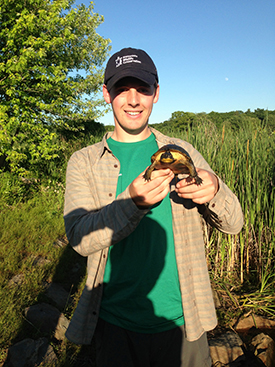
Sam Linde, another Grassroots Wildlife Conservation intern, holds one of the Blanding’s turtles caught in the trap (Photo: Don Lyman)
[WATER SOUNDS]
DOERING: In the pond at Great Meadows, Chris and I wade through the cool water to check another trap.
HICKLING: Whoa! Another Blanding’s. A big one.
DOERING: That’s really big. The shell is about nine inches long and dome-shaped.
HICKLING: Yeah. So that’s a male, because it doesn’t have a radio tracker. So that’s the easiest way to tell, because we don’t, you know…We’re concerned with finding the nests and the females, and the males have nothing to do with it at that point. This is one of the bigger ones I’ve seen. His shell’s very worn, and you can see the algae all on the shell here.
DOERING: Bryan takes a look at the turtle and recognizes it as one he’s caught before.
WINDMILLER: By looking at this guy, even though we first caught him about five years ago, this turtle is at least sixty.

Chris and Sam measure a larger Blanding’s turtle (Photo: Don Lyman)
DOERING: Blanding’s turtles have a similar lifespan to humans. Scientists guess that they can live up to ninety years, but no one is sure because there’s not enough data about the species yet. Bryan explains that these turtles we’ve just caught will contribute a couple more data points to what’s known about them.
WINDMILLER: So we’ll get these guys measured and weighed. Then they’ll be released here, but we’re gonna start on our main business for the evening, which is looking for the moms. So we’ll start by going up in the tower, and we’re gonna check with a radio tracking receiver. We’re gonna check on the signals of the moms that haven’t nested yet around here. And we’ll get a sense of where they are, and then we’re gonna go look for some of them.
[STEPS ON TOWER SOUNDS]
DOERING: The metal, twenty-foot-high tower overlooks most of Great Meadows and is a good high point for radio tracking. We meet up with Lea Kablik, a U.S. Fish and Wildlife Service biologist who helps with the tracking. Lea turns on the receiver and holds the antenna over her head, pointing it in different directions.
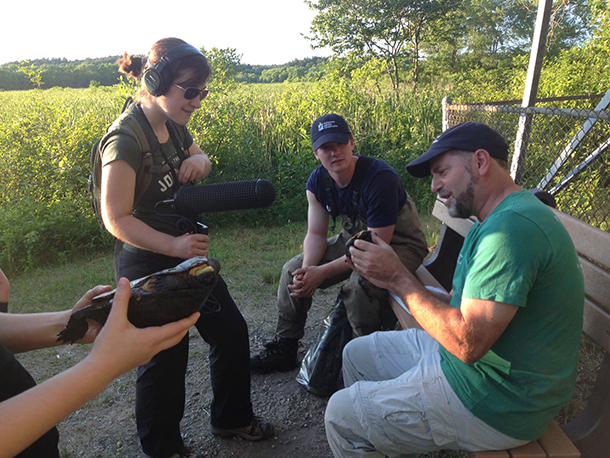
Bryan Windmiller examines turtle number 401, one of the very first turtles in Grassroots Wildlife Conservation’s head-start program. (Photo: Don Lyman)
[RADIO TRACKING BEEPS]
DOERING: The beeping sound clues Lea in to where the turtle could be. It’s faint right now because this turtle’s not close.
[RADIO TRACKING BEEPS]
DOERING: Do they all sound the same?
KABLIK: Yeah, each beep sounds the same as all the others. It’s just knowing what frequency that you have programmed into the receiver.
WINDMILLER: The turtle has a radio station. And it’s just like all the turtle radio stations. The different radio turtle stations are playing exactly the same tune, but you can listen to all the different ones that sound exactly the same just by dialing in your particular channel. So this year, altogether we’re tracking eleven females here at Great Meadows, one of whom we’re just not picking up a signal from. Two have nested, and so, with the one that’s not working, that leaves us eight to run after right now. We should go start off looking for 2028.
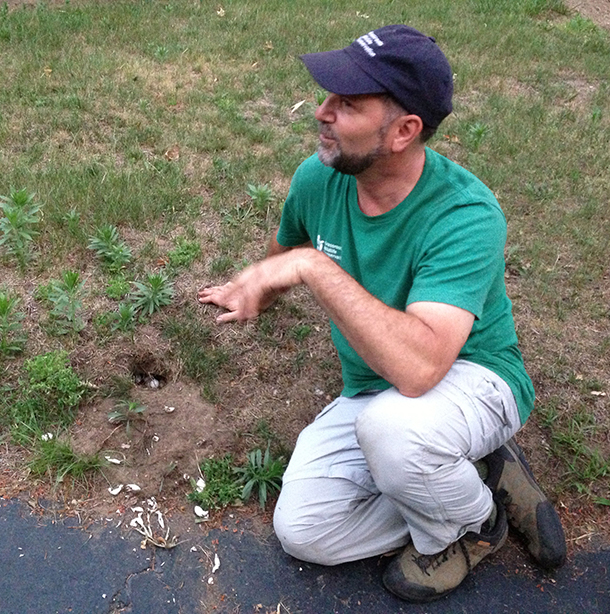
Bryan explains the predators that like to eat turtle eggs. A skunk dug up and ate most of the eggs in this snapping turtle nest, but the Grassroots Wildlife Conservation team was able to protect the remaining eggs with a mesh screen. (Photo: Don Lyman)
DOERING: We drive to a quiet neighborhood just a short distance away. The lawns are well-kept, the backyards have big shade trees, and we see several residents hanging out on their porches on this fine June evening.
WINDMILLER: Yeah, well, we’re over at the side of this house, and this is where Chris and Stephanie and Lea last night tracked turtle number 2028, and they put a little thread bobbin on her just as a visual way of tracking her in case she decided to nest late at night. Blanding’s turtles almost always nest as it’s getting dark, and usually they’re done by 11:00 or so, but some of them like to stay really late, and we don’t, so if people need to leave, then sometimes we put these thread bobbins. So as the turtle walks, the thread just spools out until it runs out, and the turtle just walks away. They don’t detain the turtle, but unfortunately in this case the thread broke, so now we’ll go find the turtle with her radio.
DOERING: Actually, it turns out a well-meaning neighbor thought the turtle was trapped, and the good Samaritan cut the thread. But on the whole, Bryan says, having the neighborhood involved is a great boon for turtle conservation.

Blanding’s turtles will sometimes make their nest next to concrete curbs (Photo: Stephanie Liszewski / Grassroots Wildlife Conservation)
WINDMILLER: If you do it right, if you involve the people to the extent that you can. The local human population can be an asset for conservation, instead of a problem. Because that’s the tendency. Biologists assume that people are always the problem. And yet, here, the turtles are nesting in people’s front yards. People are on – They tell us, they call us when they see turtles, they’re looking out for the turtles, they’re looking out for the nests. We have several thousand schoolkids in Massachusetts who raise young turtles for us as part of this conservation program, so people are in all kinds of ways directly helping out.
[RADIO TRACKING BEEPS]
DOERING: Lea starts moving around with the radio tracking equipment. Getting an accurate signal is proving difficult because the radio waves bounce off of the flat sides of the houses. I ask Bryan where the turtle we’re looking for, number 2028, would most likely be nesting.
WINDMILLER: Well, if she’s going to be nesting, she’s going to be nesting in an open, relatively sunny place. There’s a good chance the turtle right now is just continuing to kind of hide in some of the shrubs and plantings near the house. Blanding’s turtles take a long time. The moms are really meticulous about finding a good spot to nest, and they almost never nest the first night they come out of the water. They’ll often spend a few days, a week, sometimes, on land. Sometimes they’ll walk around…We’re just like chasing them around these neighborhoods, and they dig a few holes there, don’t like it, dig a few holes there, and check out an area, and sometimes they’ll go all the way back to the wetlands of Great Meadows, and they’ll hang out in the water and come back a few days later and finally nest.
Lea Kablik, a U.S. Fish and Wildlife Service biologist, uses radio tracking equipment to try to find the nesting turtle (Photo: Don Lyman)
[RADIO TRACKING BEEPS]
DOERING: We keep searching for 2028, but she’s proving elusive. A resident comes up to Lea to say she’d seen the turtle not long before.
NEIGHBOR: Okay, She was like right up on the pavement. And just wanted to let you know, that was the last time I saw her… maybe 45 minutes ago?
KABLIK: Oh, really! Okay.
NEIGHBOR: Yeah, yeah. So it wasn’t that long.
KABLIK: Okay, Thank you.
NEIGHBOR: And I’m not sure how fast they move!
KABLIK: Surprisingly fast.
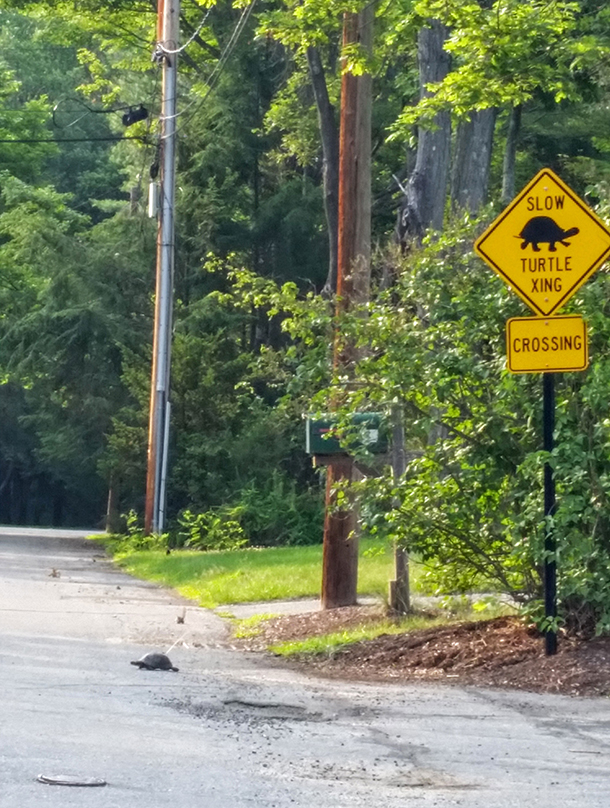
‘Why did the turtle cross the road?’ Perhaps to make her nest in a Concord neighborhood. (Photo: Emilie Schuler / Grassroots Wildlife Conservation)
NEIGHBOR: It had the antenna, and it had duct tape on it. She was basically where that watering can is.
WINDMILLER: By far the loudest spot is still in the ivy here.
[LOUDER RADIO TRACKING SOUNDS AND RUSTLING THROUGH IVY SOUNDS]
DOERING: Finally Bryan locates the turtle in the front yard of the house next door.
WINDMILLER: Yeah, she’s in the mulch.
HICKLING: Looks like she’s digging right now. You can see the pile of mulch just behind her that she’s kicked out of the way right there, on the edge.
WINDMILLER: Yeah, she’s definitely working. She’s certainly trying to do something over there.
DOERING: We need to be really quiet and keep our distance to make sure we don’t disturb her.
WINDMILLER: Yeah, I mean, you never know, the turtles are funny. Turtles who nest over here are obviously used to seeing people, and, I think, we caught this turtle – This is 2028 – I think we first caught this turtle ten years ago as a juvenile. It’s a pretty young mom. So she’s used to people. But just instinctively, Blanding’s turtles, all turtles are very wary when they’re first starting to commit to laying their eggs. Once they start laying their eggs, it’s like they go in a trance, and it doesn’t matter what’s going on around them. They’re going to try and finish. But before she actually starts laying her eggs and commits herself to her nesting spot, the best thing is to leave her be right now. She’s clearly, if she’s digging, she’s just started. So the best thing is for us to go concentrate on the other turtles, see where they are right now. And then we’ll come back and check on her later and see what she’s doing.
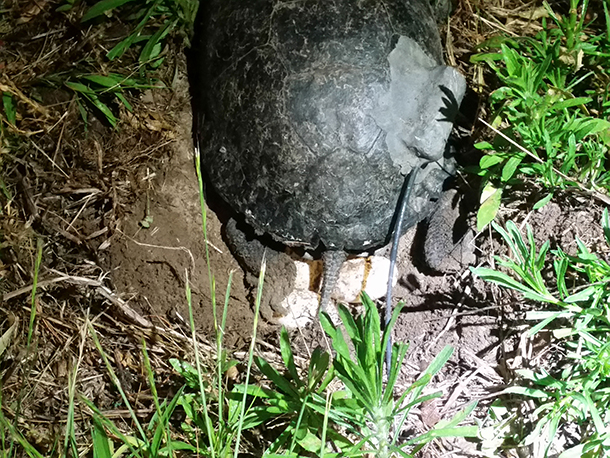
A Blanding’s turtle lays eggs in a nest at Borderland State Park in Massachusetts (Photo: Emilie Schuler / Grassroots Wildlife Conservation)
DOERING: With Bryan and the rest of the team we walk over to the edge of Great Meadows, just down the street from the nesting turtle, to try to check on the other females. Chris explains how the tracking works each night.
[RADIO TRACKING BEEPS]
HICKLING: The first thing we do is we usually check from the tower, to get kind of a signal of whether they’re in the lower or upper pool.
WINDMILLER: By this time of evening, if the turtle is in the swamp, she’s not gonna nest tonight. I mean, we’re like 99% sure. The turtles are individuals, you get some turtles that don’t read the books, want to do their own thing, and decide at 2:00 in the morning to come out and nest, and we’re just not gonna find that one. But the great majority of turtles, if they’re still in the water this time of evening, they’re not nesting tonight. So that’s really what we’re trying to do is sa”OK, is it in the water, that way, or are we missing it, and maybe it’s over here on land and we need to go find it.”
DOERING: The radio signals tell them that the other female turtles are all in the water, so we go back to the house where number 2028 is digging her nest in the mulch, to see if we can gauge her progress.
[CRICKETS, RUSTLING SOUNDS]
DOERING: It’s hard to tell, but Bryan has a guess.
[MORE CRICKETS, BIRDS]

Bryan gently digs in the mulch in front of a Concord home to uncover the first few eggs in turtle 2028’s nest. (Photo: Don Lyman)
WINDMILLER: She’s got a big hole. I think she’s just starting to cover up, because I couldn’t see the eggs in there, so I’m guessing that she’s already pushed some dirt over the top egg. Yeah, so at this point it’s nice because I’m in my neighborhood, and this is the point where I usually go over to my house, I sit down, watch a little bit of the Red Sox game if they’re still on, have a beer, come out in half an hour, check on her. She’ll probably spend, at this point, because she’s got still a lot of a hole to fill, she’ll probably spend another hour or so over here. They’re kind of very slow but steady.
DOERING: While we wait, Bryan explains that the ponds at Great Meadows National Wildlife Refuge aren’t actually natural. People created them as duck ponds for hunting, and many of the turtles still living at Great Meadows were here first.
WINDMILLER: They pre-date Great Meadows. Those ponds were created in the 1950s. So a lot of the older turtles at least were alive before those ponds were created. So they’re used to, or at least were born into, a radically different environment. Henry David Thoreau caught a Blanding’s turtle at Great Meadows in 1854. He killed it because a buddy of his, Louis Agassiz, had started the Museum of Comparative Zoology at Harvard and really wanted a Blanding’s turtle for his collection, so Thoreau gave him a Blanding’s turtle and then wrote in his journal about how guilty he felt over killing the Balnding’s turtle, and you can still see the Blanding’s turtle on display at the MCZ at Harvard. And so the turtles were here, but the environment was totally different. I mean, you imagine it was called Great Meadows because a lot of it was the wetlands, were shallow, much more open, but not ponds.
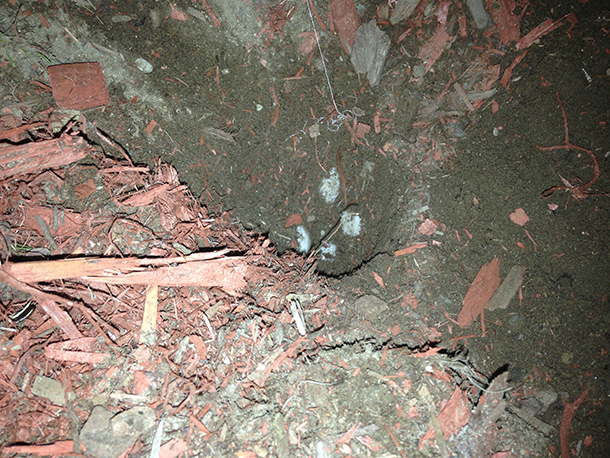
The first few eggs in the nest dug by turtle 2028 (Photo: Don Lyman)
DOERING: An hour or so later we return to the nest site…and turtle 2028 is gone. Bryan gently digs in the mulch to uncover her nest.
WINDMILLER: There we go.
DOERING: That’s pretty cool.
WINDMILLER: So we can just expose the top three eggs of her nest – actually you can see at least four. They’re about four inches deep. We’re very glad, she started about 7:30. It’s now about 11:30, looks like she pretty recently finished, so this is awesome. And this is really a typical kind of place for the Blanding’s turtles to nest here. She’s kind of near their stone paved walkway over to the front entrance of the house. And right in their mulch bed by their little perennial border about ten feet off the side of the house, a very nice spot for her nest. So now we’ll just cover it back up with dirt, like she did, like Mom did, and put a screen over it so raccoons and skunks can’t get it.
DOERING: Bryan goes to the car to get the protective metal screen and stakes.
[METAL CLINKING; CAR DOOR SLAMS]
WINDMILLER: So here in the suburbs it’s mostly skunks and raccoons. Foxes dig up turtle nests sometimes too. In this neighborhood in particular, there are a lot of skunks around here, and they’re very good at finding turtle eggs.
[METAL SOUNDS]
DOERING: Bryan thinks that nesting Blanding’s turtles may intentionally find refuge in housing developments.
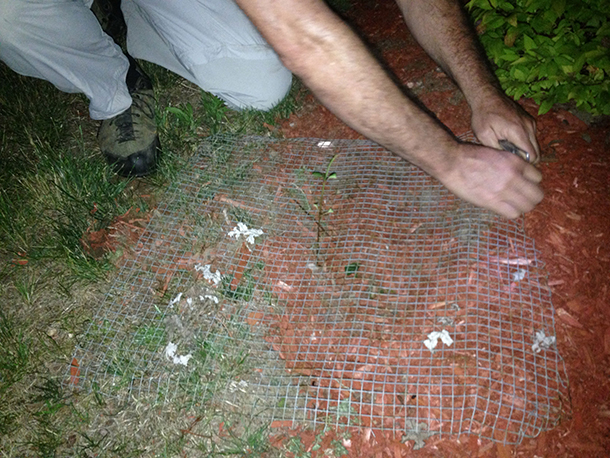
Covering the nest with a mesh screen protects it from predators like skunks and raccoons (Photo: Don Lyman)
WINDMILLER: The great majority of them nest in places just like this, right by people’s houses. And at least I like to believe that the turtles have figured it out, that this is actually in many ways a better place for them to nest. First, they’re able to find these warmer little microhabitats, next to asphalt driveways, and little bits of landscape rock, and in mulched areas, where also the mulch will absorb some of the sun’s radiation. But in addition I think the turtles may have learned that when they nest in a place like this right up against somebody’s house, it’s really rare for raccoons and skunks to bother them.
[MORE METALLIC SOUNDS]
DOERING: He lays a square of chicken-wire mesh on the spot where the nest is buried and pushes metal stakes firmly into the mulch to hold it down.
[METAL SOUNDS]
DOERING: With the screen in place, turtle 2028’s nest is protected, and for tonight, the work of Bryan Windmiller, Chris Hickling, Lea Kablik, and Grassroots Wildlife Conservation is done.
WINDMILLER: And then we just wait, and we put the temperature loggers down by the eggs to monitor the nest temperature so we can try and guess whether they’re gonna be boys or girls. And just wait until late August or September, when the babies come out.
DOERING: And we plan to be back, too, to check on those babies when they hatch. For Living on Earth, I’m Jenni Doering in Concord, Massachusetts.
Links
Grassroots Wildlife Conservation’s Blanding’s Turtle Monitoring and Headstarting project
2014 report on GWC’s Blanding’s turtle project
More about the Blanding’s turtle from the Massachusetts Division of Fisheries & Wildlife
About Great Meadows National Wildlife Refuge
Blanding’s turtle specimen caught by Henry David Thoreau for Louis Agassiz
Living on Earth wants to hear from you!
Living on Earth
62 Calef Highway, Suite 212
Lee, NH 03861
Telephone: 617-287-4121
E-mail: comments@loe.org
Newsletter [Click here]
Donate to Living on Earth!
Living on Earth is an independent media program and relies entirely on contributions from listeners and institutions supporting public service. Please donate now to preserve an independent environmental voice.
NewsletterLiving on Earth offers a weekly delivery of the show's rundown to your mailbox. Sign up for our newsletter today!
 Sailors For The Sea: Be the change you want to sea.
Sailors For The Sea: Be the change you want to sea.
 The Grantham Foundation for the Protection of the Environment: Committed to protecting and improving the health of the global environment.
The Grantham Foundation for the Protection of the Environment: Committed to protecting and improving the health of the global environment.
 Contribute to Living on Earth and receive, as our gift to you, an archival print of one of Mark Seth Lender's extraordinary wildlife photographs. Follow the link to see Mark's current collection of photographs.
Contribute to Living on Earth and receive, as our gift to you, an archival print of one of Mark Seth Lender's extraordinary wildlife photographs. Follow the link to see Mark's current collection of photographs.
 Buy a signed copy of Mark Seth Lender's book Smeagull the Seagull & support Living on Earth
Buy a signed copy of Mark Seth Lender's book Smeagull the Seagull & support Living on Earth

